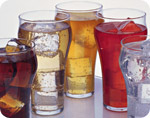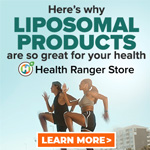
Why Soft Drinks Contribute to Obesity
Monday, September 01, 2008 by: Helmut Beierbeck
Tags: obesity, health news, Natural News
- Newly released JFK files reveal Pentagon's role in creating Lyme disease and covid in the same lab
- Here are TEN all-natural ways to protect your garden without using harmful chemicals
- Ginseng's hidden anti-aging power: How compound K is rewriting the rules of skincare
- “Endgame: The Hidden Agenda 21” unveils a world of conspiracy and control
- L.A.'s rebuilding nightmare: Only 4 permits issued after fire destroys 6,000 homes
- Scientists demand FDA withdraw mRNA COVID vaccines amid contamination and gene therapy concerns
- Senate Democrats deny censorship industrial complex existed, defend government's role in silencing dissent
- “The shame of Minnesota”: Somali immigrants behind $250 million child nutrition fraud in largest COVID-era scam
- Former Congresswoman exposes CCP's deep infiltration of California through universities, ports, and fentanyl
- Dr. Suzanne Humphries makes bombshell appearance on Joe Rogan podcast, exposing vaccine industry deception back to POLIOMYELITIS
- Despite surge in MMR vaccination in Texas, measles outbreaks continue: Is VACCINE SHEDDING fueling the spread?
- PROCESSED TABLE SALT in foods found to fuel depression
- Chewing gum's dirty secret: How your daily habit could be flooding your body with microplastics
- BPA: The hidden hormone disruptor sabotaging your health - and how to fight back
- “Independent” anti-Russia outlet MEDUZA faces COLLAPSE as US funding dries up
- Embracing the wild: A deep dive into Jim Cobb’s “Backwoods Survival Guide”
- The hidden battle in your glass: How A1 and A2 milk could shape your health
- Nomi Prins reveals how central bankers reshaped the global economy in “Collusion”
- Newly released JFK files reveal Pentagon's role in creating Lyme disease and covid in the same lab
- Analysis: The coming economic collapse, a mass uprising and Trump's three secret weapons to halt the growing revolt
- Festive flavors: The sweet history, nutritional profile and health benefits of pecan pie
- Elon Musk: Aliens could be here on Earth RIGHT NOW
- Trump reverses course on Gaza plan, says “nobody is expelling Palestinians”
- Big Pharma's $8 Billion bribery scheme exposed: how doctors are pushed to prescribe junk science, not heal
- Boys are back in town: Trump’s patriotic alpha crew takes the wheel while toxic females ride in the backseat
- Reclaim your health: How midlife exercise reverses years of inactivity
- A lack of integrity in Academia: Harvard professor found GUILTY of fraudulent research to promote CRT theory
- Survival 101: Effective EMF blocking techniques
- EPA advisor admits the agency is funneling billions to climate groups ahead of Trump’s return to White House
- Dr. Mike Yeadon releases 15-minute testimony - WATCH - about genocidal intent of COVID “vaccines”
- 5 Simple steps to boost your brainpower: How to strengthen executive function in a distracted world
- Florida takes a stand: DeSantis proposes permanent ban on mRNA vaccine mandates
- Sugarcane extract superior to cholesterol-lowering drugs?
- Mike Adams Sermon 66: God will DESTROY ISRAEL for its wickedness
- Pilots report mysterious lights 'moving at extreme speeds' across Oregon skies
- Space war brewing? Russia threatens to destroy Starlink satellites
- EPA advisor admits the agency is funneling billions to climate groups ahead of Trump’s return to White House
- California's social media censorship law struck down: A victory for free speech or a threat to online safety?
- The Health Ranger releases “Vaccine Zombie” song and music video, using AI-animated zombies for the music video
- Dr. Mike Yeadon releases 15-minute testimony - WATCH - about genocidal intent of COVID “vaccines”
- The pandemic as a tool for INDOCTRINATION: Understanding “The Indoctrinated Brain” by Dr. Michael Nehls
- Newly released JFK files reveal Pentagon's role in creating Lyme disease and covid in the same lab
- Florida takes a stand: DeSantis proposes permanent ban on mRNA vaccine mandates
- Mike Adams releases country western hit single: Goin’ Back in Time is Comin’ Home
- Mike Adams releases music poetry sensation: A Child of God
- “Why we influenced the 2020 elections”: Facebook files reveal the coordinated effort to bury the Hunter Biden laptop story
- Unpacking the Lies That We’ve Been Fed – new song and music video released by Mike Adams, the Health Ranger
- RFK Jr. clears key hurdle: Sen. Susan Collins backs controversial HHS nominee, signaling a new era for health policy
- Mike Adams releases new song and music video: Nothing More Disgusting Than a Globalist
- Michigan sheriff announces criminal investigation into 2020 election crimes, Dominion Voting Systems
- Israeli soldiers accused of even more torture and abuse in the West Bank
- Migrants are taking advantage of recent hurricanes to scam residents and loot their homes
- House Intelligence Committee calls for the ARREST and PROSECUTION of Dr. Anthony Fauci
- Rep. Nancy Mace introduces bill to ban biological males from female facilities on federal property
- Red Cross issues warning to stop blood plasma donations from vaccinated people
- Scientists confirm: GENIUS brain function can be spontaneously unleashed in humans without any apparent cause
- EPA advisor admits the agency is funneling billions to climate groups ahead of Trump’s return to White House
- HYSSOP: What research reveals about the health benefits of this ancient holy herb
- Two containers with completed ballots fall out of truck in Florida
- Fully vaccinated about to see “tsunami” of illness and death, warns virologist
- Global leaders unite to clamp down on “misinformation” with UN-backed Cascais Declaration
- BREAKING: 2025 NDAA authorizes mandatory military draft of WOMEN across America… as Pentagon pursues global NUCLEAR war with both Russia and China at the same time
- Michael Yon warns of a ZIONIST TAKEOVER in Trump’s second administration
- BOMBSHELL: DNA testing kits are a SCAM to develop ethnic-specific bioweapons
- Ozempic and Wegovy weight loss drugs are injectable LIZARD VENOM PEPTIDES that may unleash a devastating wave of organ failure… side effects align with symptoms of SNAKE BITES
- Israeli soldiers accused of even more torture and abuse in the West Bank
- These 13 countries just signed an agreement to engineer a global FAMINE by destroying food supply
- NASA admits that climate change occurs because of changes in Earth’s solar orbit, and NOT because of SUVs and fossil fuels
- RFK Jr. clears key hurdle: Sen. Susan Collins backs controversial HHS nominee, signaling a new era for health policy
- Sermon 30: How Jesus reveals Caesar’s FAKE CURRENCY and FALSE AUTHORITY
- Coriander seeds: Ancient medicine backed by modern science
- Arizona officials claim Maricopa County needs 10-13 days to tabulate results of the election
On the other hand, obesity rates also increased in Europe and other parts of the world where sucrose (table sugar) remained the major caloric sweetener. This seemed to argue against a connection between HFCS and weight gain, particularly since the fructose/glucose ratios of high fructose corn syrup and sucrose are quite similar.
What sucrose and high fructose corn syrup have in common, and what distinguishes them from dietary carbohydrates such as starch, is their fructose content. Fructose contributes the same amount of energy as glucose, but it doesn′t trigger the same satiety signals. The sharp rise in the consumption of soft drinks and processed foods sweetened with HFCS and sucrose led to a dramatic increase in fructose intake, a source of energy that goes essentially unnoticed.
What is high fructose corn syrup?
High fructose corn syrup is made from corn starch, a glucose polymer. First, enzymatic starch breakdown yields corn syrup which is essentially free glucose. The glucose is then further enzymatically converted to fructose. After various purification steps, a mixture of 90% fructose and 10% glucose (HFCS-90) is obtained. HFCS-90 is mixed with appropriate amounts of corn syrup to make either HFCS-55 or HFCS-42, mixtures with 55% and 42% fructose, respectively. HFCS-55 is mainly used for soft drinks, whereas HFCS-42 is primarily used to sweeten baked goods.
Not only are sucrose and high fructose corn syrup similar in their fructose/glucose ratios, but soft drinks are acidic enough to hydrolyze sucrose. An analysis of sucrose-sweetened soft drinks showed that ten days after manufacture only 50% of the sucrose was still intact. After three months 90% of the sucrose was hydrolyzed, i.e. even sucrose-sweetened soft drinks contain mostly free fructose and glucose (2).
HFCS has largely replaced sucrose in commercial foods in North America. It is cheaper than sucrose, partly because of import tariffs on sucrose and agricultural subsidies to corn producers.
HFCS versus sucrose in drinks - is there a difference?
37 men and women in their twenties and in the healthy weight range were recruited to compare the effects of soft drinks sweetened with sucrose and HFCS on subsequent food intake (2). At mid-morning the participants were given one of six preloads: 215 kcal from sodas sweetened with sucrose, HFCS-42, or HFCS-55, 215 kcal from 1% milk, 4 kcal from aspartame-sweetened diet soda, or no drink at all. Later all subjects were given the same lunch and they were free to eat as much as they wanted. Leftover food was weighed, giving the investigators an accurate measure of energy intake. Averaged over six lunches, the following total calorie intakes (in kcal) from preload plus lunch were found: HFCS-42 1193, HFCS-55 1182, sucrose 1170, 1% milk 1129, aspartame 1011, and no drink 1008.
Clearly, there was no signficant difference between the sodas sweetened with sucrose and those with HFCS. In addition, the subjects drinking caloric preloads clearly took in more total calories than those drinking the low-cal soda or nothing at all. In other words, those who had caloric drinks before lunch did not reduce their food intake sufficiently to compensate for the preload.
Sugars in solid versus liquid form - does it matter?
To answer this question, 15 men and women were recruited for a short cross-over trial designed to compare the effects of equicaloric liquid and solid carbohydrate sweeteners on food intake (3). All participants were in their twenties and in the healthy weight range.
The trial consisted of two four-week interventions, separated by a four-week washout period and cross-over. Once a week during the two trial phases the participants presented themselves to the investigators to be weighed and supplied with weekly rations of their daily 450 kcal sweeteners. The solid load consisted of sucrose-sweetened jelly beans, and the liquid load of HFCS-sweetened soda. The
participants were free to decide when to take their daily loads, and when and what to eat. Calorie intake was estimated from self-assessments of food consumption.
Analysis of the food questionnaires indicated that during their solid phase the subjects fully compensated for the energy content of their preload; the total calorie intake from food plus test sweetener was equal to the pre-trial food energy intake. This was not the case, however, during their liquid trial phase, where food intake remained unchanged, i.e. the sweetened drink added to the total calories.
While conclusions based on self-reporting of food eaten are always questionable, these were within-subject comparisons, i.e. the same bias was likely present in their estimate of food intake after liquid and after solid preloading. Furthermore, the estimated energy intakes were consistent with measured changes in body weight. The participants experienced significant weight gains during the liquid trial phase, but not during the solid trial phase, consistent with an excess energy intake in the liquid phase.
It appears therefore that caloric sweeteners contribute to weight gain if consumed in drinks, but not in solid food.
Fructose and glucose affect appetite and food intake differently
Two hormones, insulin and leptin, act as satiety signals in the brain and thus are critical to energy homeostasis (4). Both insulin and leptin circulate in the blood at levels proportional to body fat content, and enter the central nervous system in proportion to their plasma levels. Low hormone levels increase appetite, and high levels act to reduce energy intake.
Insulin levels rise in response to blood glucose. Insulin-mediated entry of glucose into adipocytes (fat cells) in turn causes the release of leptin. In other words, both insulin and leptin levels react to glucose concentrations. Fructose, on the other hand, does not trigger insulin release. This in turn means that fructose doesn′t affect leptin levels either. Since it increases neither insulin nor leptin levels, fructose consumption does not generate the same satiety signals as glucose. The result is overeating and weight gain.
Summary
To summarize, the rise in obesity rates with increasing HFCS consumption was no coincidence. The increased popularity of soft drinks and HFCS-sweetened convenience foods led to a rapid increase in fructose consumption. It was this excessive fructose intake that fuelled the rapid weight gain, since fructose does not generate the same satiety signals as glucose. It is likely that sweetened drinks are worse than sweet solid foods, and that sucrose has the same effect as high fructose corn syrup.
Most studies of the effects of calorically sweetened liquids on appetite and weight gain looked at soft drinks. However, fruit juices and drinks also contain added sweeteners, typically HFCS, i.e. they pose the same obesity risk. Switching to noncalorically sweetened soft drinks isn′t the answer either, since artificial sweeteners like aspartame come with problems of their own (5).
Of course fruit also contains fructose ("fruit sugar"), but this obviously doesn′t mean that one should stop eating fruit. It doesn′t contain nearly as much fructose as sweetened drinks and it is a valuable source of phytonutrients and fiber, whereas soft drinks provide little more than empty calories.
Clearly, one of the best things we can do for our health is to stop drinking soft drinks.
References:
1. Bray GA, Nielsen SJ and Popkin BM. Consumption of high-fructose corn syrup in beverages may play a role in the epidemic of obesity. Am J Clin Nutr 2004;79:537-543.
(http://epsl.asu.edu/ceru/Articles/CERU-0406-...)
2. Monsivais P, Perrigue MM and Drewnowski A. Sugars and satiety: does the type of sweetener make a difference? Am J Clin Nutr 2007;86:116-123.
(http://www.ajcn.org/cgi/reprint/86/1/116)
3. DiMeglio DP and Mattes RD. Liquid versus solid carbohydrate: effects on food intake and body weight. Int J Obes 2000;24:794-800.
(http://www.nature.com/ijo/journal/v24/n6/pdf...)
4. Schwartz MW, et al. Central nervous system control of food intake. Nature 2000;404:661-671. (http://www.saegre.org.ar/docs/schwartz_2000....)
5. JAMA questions sense of sweeteners for weight loss. NutraIngredients May 18,
2008.
About the author
Helmut Beierbeck has a science background and a strong interest in all scientific aspects of health, nutrition, medicine, weight loss, or any other topic related to wellness. You can follow his ruminations on his blog http://healthcomments.info and leave comments on this or any other health-related topic.Obesity at FETCH.news
Get independent news alerts on natural cures, food lab tests, cannabis medicine, science, robotics, drones, privacy and more.
Take Action: Support Natural News by linking to this article from your website
Permalink to this article:
Embed article link: (copy HTML code below):
Reprinting this article:
Non-commercial use OK, cite NaturalNews.com with clickable link.
Follow Natural News on Facebook, Twitter, Google Plus, and Pinterest
Science News & Studies
Medicine News and Information
Food News & Studies
Health News & Studies
Herbs News & Information
Pollution News & Studies
Cancer News & Studies
Climate News & Studies
Survival News & Information
Gear News & Information
News covering technology, stocks, hackers, and more



"Big Tech and mainstream media are constantly trying to silence the independent voices that dare to bring you the truth about toxic food ingredients, dangerous medications and the failed, fraudulent science of the profit-driven medical establishment.
Email is one of the best ways to make sure you stay informed, without the censorship of the tech giants (Google, Apple, Facebook, Twitter, YouTube, etc.). Stay informed and you'll even likely learn information that may help save your own life."
–The Health Ranger, Mike Adams












































